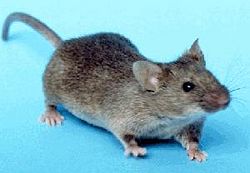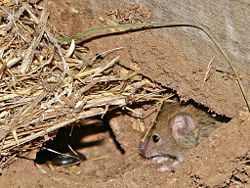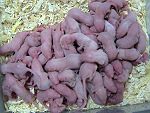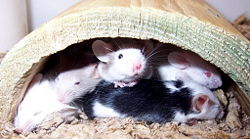Mouse
| Mouse
| ||||||||||||||||
|---|---|---|---|---|---|---|---|---|---|---|---|---|---|---|---|---|
 House mouse, Mus musculus
| ||||||||||||||||
| Scientific classification | ||||||||||||||||
|
A mouse (Plural mice) is a mammal that belongs to one of numerous species of small rodents. The best known mouse species is the common house mouse (Mus musculus). It is found in nearly all countries and, as the laboratory mouse, serves as an important model organism in biology; it is also a popular pet. The American white-footed mouse (Peromyscus leucopus) and the deer mouse (Peromyscus maniculatus) also sometimes live in houses. These species of mice live commensally with humans.
Although they may live up to two years in the lab, the average mouse in the wild lives only about 3 months, primarily due to heavy predation. Cats, wild dogs, foxes, birds-of-prey, snakes and even certain kinds of insects have been known to prey heavily upon mice. Nevertheless, due to its incredible adaptability to almost any environment, and its ability to live commensally to humans, it is regarded to be the second most successful mammalian species living on earth today, after the rat.
Mice can be harmful pests, damaging and eating crops and spreading diseases through their parasites and feces. In the Western U.S., breathing dust, which has come in contact with mouse feces, has been linked to the deadly Hantavirus. The original motivation for the domestication of cats is thought to have been for their predation of mice and their relatives, the rats.
Body and behavior
Mice are small rodents, resembling diminutive rats. Usually they have pointed snouts and small ears. The body is typically elongated with slender usually hairless tails, but different types of mice show large variations. Body dimensions vary considerably by species. Here are some approximate values: total length 28-130 mm, mass: 2.5 to >34g[1]
Mice generally live on a herbivore diet, but are actually omnivores: they will eat meat, the dead bodies of other mice, and have been observed to self-cannibalise their tails during starvation. Grasshopper mice are an exception to the rule, being the only fully carnivorous mice. Mice eat grains, fruits, and seeds for a regular diet, which is the main reason they damage crops. They are also known to eat their own droppings on rare occasions.
Mice are social animals. They prefer to live in groups. Male rivalry can become harmful for the animal, especially when confined to little space. The natural habitats of the mouse are very diverse. Mice can be found in forests, savannahs, grasslands and rocky habitats [1]. In Africa they tend to particularly like forest edge, derived savannah, and of course agricultural areas. Mice build nests for protection and warmth but species have different preferences: M. minutoides nests in shallow burrows. M. caroli and M. cervicolor burrow. M. shortridgei and M. pahari nest aboveground. Most species will construct nests of grass, fibers, and shredded material [1]. Mice do not hibernate.
The mouse has bichromatic vision, lacking a photopigment that can detect red light.[2]
Taxonomy of the genus Mus
The term "mouse" in common usage is roughly equivalent to the taxonomic term Mus, while house mouse is equivalent to Mus musculus. In common language the term "mouse" often refers incorrectly to Mus musculus. However, there are 38 species of mice (in the genus Mus), see table below.
| Genus Mus | |||||||
|---|---|---|---|---|---|---|---|
| Subgenus Pyromys | Subgenus Coelomys | Subgenus Mus | Subgenus Nannomys | ||||
|
|
|
|
|
|
|
|
Laboratory mice
Mice are the most commonly utilized animal research model with hundreds of established in bred, out bred, and transgenic strains. In the United States, they are not covered under the Animal Welfare Act (AWA) (administered by the USDA, APHIS) as an animal. However, the Public Health Service Act (PHS) as administered by the National Institutes of Health (NIH) does cover their humane treatment.
Mice are common experimental animals in biology and psychology primarily because they are mammals, and thus share a high degree of homology with humans, but can be manipulated in ways that would be considered unethical to do with humans and that is why they test them on mice instead. They are a primary mammalian model organism, as are rats.
Additional benefits of mice in laboratory research include the fact that mice are small, inexpensive, and several generations can be observed in a relatively short period of time. The mouse genome has been sequenced, and virtually all mouse genes have human homologs.
History
Mouse-like species are among the oldest mammals. It has been proposed that higher mammals evolved from rodent-like species many million years ago.
Mice have been known to humans since antiquity. The Romans differentiated poorly between mice and rats, calling rats Mus Maximus (big mouse) and referring to mice as Mus Minimus (little mouse). In Spanish similar term are in use: ratón for mouse and rata for rat [1].
Discoloration in mice was supposedly first noticed in China by 1100 B.C.E., where a white mouse was discovered. However, there is sufficient evidence to believe that white mice were first noticed before that, in the times of the Greeks and Ancient Rome.
The word "mouse" and the word muscle are related. Muscle stems from musculus meaning small mouse - possibly because of a similarity in shape [2] [3]. The word "mouse" is cognate with Sanskrit mush meaning 'to steal' which is also cognate with mys in Old Greek and mus in Latin [4].
Mice as feeder animals
A very common use of mice currently is to feed many species of snakes, lizards, and even tarantulas. Most US pet stores now carry mice for this purpose. Because they breed quickly, grow quickly, are easy to care for, they can be sold in a wide variety of sizes. This makes them suitable for consumption by animals of many different sizes. Mice also seem to be a desirable food item for a very large variety of carnivores. Common terms used to refer to different age/size mice are pinkies, fuzzies, hoppers, and adults. Pinkies are newborn mice that have not yet grown fur. Fuzzies have some fur but are generally not very mobile, hoppers have a full coat of hair and are fully mobile but are smaller than adult mice. These terms also refer to the various growth stages of rats (also see Fancy rat).
Mice specifically bred for pets and feeders are sometimes called fancy mice.
Mice as pets
- Main article: Fancy mouse
Mice are now one of the leading rodent pets. Although their main purpose in pet stores is to be sold as snake food, many people buy mice as companion pets. Some common products used are:
- Cage- Usually a hamster or gerbil cage, but special mouse cages are now available
- Food- Special pelleted and seed-based food is available.
- Bedding- Usually hardwoods, such as aspen. Cedar or pine should not be used because it contains harmful liquids that can damage any rodent's respiratory system. Corn cob bedding should also not be used because it promotes Aspergillis Fungus and can grow mold once it gets wet. It also is quite rough on their feet. Recycled virgin wood pulp is also used.
Some benefits of having mice as pets are
- Minimal shedding and allergens
- Entertaining and affectionate
- Inexpensive
- Clean (contrary to popular belief)
- Socially self-sufficient (when in a group of other mice)
- Mice are significantly less likely to bite than other rodent pets.
- Mice are quite intelligent given their size
There are, however, some disadvantages to having pet mice
- Small and quite fragile (not as easy to handle as a dog or a cat)
- Nocturnal
- Frequent eye infections under stress
- Easily subject to disease when without optimal care
- Frequent reproduction
- Short lifespan
Mice in popular culture
- Main article: Mice in fiction
- In Of Mice and Men, the novel by John Steinbeck, the character Lennie has a particular fascination of mice.
- The cartoons Danger Mouse and Mighty Mouse also depict mice with high regard.
- The smartest organisms in the universe in The Hitchhikers Guide to the Galaxy are mice.
- One of the two heroes in a popular cartoon Tom and Jerry is a mouse named Jerry, who is portrayed as engaging in perpetual, yet sometimes friendly, combat with the other hero, a cat named Tom.
- The main characters in a cartoon called Pinky and the Brain.
- The widely known Mickey Mouse is the spokesman of Disney.
- The famous Geronimo Stilton is the protagonist of the eponymous book series.
- Mice are portrayed as heroes and have human-like characteristics in the book series Redwall.
- All of the Jews in Maus a graphic novel about the Holocaust are depicted as mice.
- The Cartoon Speedy Gonzalez is a mouse
- Edward Delacroix trains a mouse who lives to be well over 60 years old in The Green Mile
See also
- House mouse
- Mouse trap
- Mice in fiction
- Fancy mouse
- Fear of mice
- Vacanti mouse
ReferencesISBN links support NWE through referral fees
- ↑ 1.0 1.1 1.2 Nowak, Ronald M. 1999. Walker's Mammals of the World, 6th edition. Johns Hopkins University Press, 1936 pp. ISBN 0-8018-5789-9
- ↑ Jacobs GH, Williams GA, Fenwick JA. Influence of cone pigment co-expression on spectral sensitivity and color vision in the mouse. Vision Res. 2004; 44(14):1615-22
External links
- Impact of Mice on endangered species
- High-Resolution Images of the Mouse Brain
- E. Eisen chapter 1: history of the mouse
- Discoloration in mice; The history of mice
- Rat@Genesh 'Ganesh rides a Mouse'
Mice as pets
- Fancy Mice 'A complete resource for pet owners and show breeders'
- PetCo (see care sheets for pet mouse information)
- Mice at PetWebSite
- Mice fansite
- Mice fanlisting
- Mice as pets
Credits
New World Encyclopedia writers and editors rewrote and completed the Wikipedia article in accordance with New World Encyclopedia standards. This article abides by terms of the Creative Commons CC-by-sa 3.0 License (CC-by-sa), which may be used and disseminated with proper attribution. Credit is due under the terms of this license that can reference both the New World Encyclopedia contributors and the selfless volunteer contributors of the Wikimedia Foundation. To cite this article click here for a list of acceptable citing formats.The history of earlier contributions by wikipedians is accessible to researchers here:
The history of this article since it was imported to New World Encyclopedia:
Note: Some restrictions may apply to use of individual images which are separately licensed.




